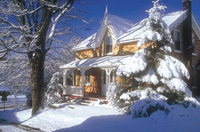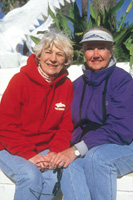Nikon N55
Affordable Entry Level Model With High Tech Capabilities
Although Nikon is best known for professional SLR cameras like the F5 and F100, they sell far more of the entry-level and mid-range models. That's understandable, because such cameras are more compact, simpler to operate, and priced to suit the budgets of millions of consumers. The N55 is the latest of the affordable Nikon SLRs and it's the lowest priced body offered by Nikon, making it highly competitive with other brands. Targeting the first time buyer, the N55 is not a bare-bones model; it incorporates advanced technology and some capabilities of interest to the budding photo enthusiast. I had the opportunity to test the N55 during another of my trips to sunny Florida and then in winter photography closer to home. Subjects included people and dolphins at Marineland, land and cityscapes, colorful birds, and the rustic homes in a village blanketed by snow. For an entry-level camera, the N55 performed surprisingly well; it also offered just enough features to satisfy my basic needs in stock photography. Physical Attributes |
|||
All controls are readily visible and well marked. Any of the 10 operating modes can be quickly accessed with the single large mode selector dial. Naturally, there are some buttons, too, for selecting functions such as exposure compensation and bracketing, the self-timer, focus area and flash modes. All essential shooting data is provided in the viewfinder, while the external LCD panel provides even more feedback on settings. Evaluation: Thanks to the mode selector dial and the auto pop-up flash, the N55 offers point-and-shoot simplicity in Program modes. Even first time SLR buyers can begin shooting without studying the instruction manual. The N55 also offers functions that are necessary for more serious photography, easily accessed by pressing the pertinent button and rotating the command dial. Anyone with experience using an electronic SLR camera will find operation intuitive; after scanning the instruction manual for five minutes, I never needed to refer to it again. Light Metering Options Evaluation: Some of today's entry-level cameras offer only evaluative metering and an exposure compensation control. Hence, the ability to select the partial-area pattern and/or exposure bracketing may be a plus for some owners. Like most of the very affordable models, the N55 did tend to underexpose in backlighting, and with bright beach and snow scenes in Matrix metering. When shooting slide film in such situations, I simply set a +1 compensation factor and bracketed in half stops. At least one of the three slides was usually perfect. With more typical subjects and lighting, the 3D Matrix metering system produced well-exposed slides. |
|||
Of course, the vast majority of N55 owners will use color negative film. Because such films have a far wider exposure latitude, Matrix metering should produce printable negatives in just about any situation except in strong backlighting. For even better results in quick shooting, I would permanently set a +0.5 exposure compensation factor. Possible in any mode except Full Auto and the subject-specific Programs, this tactic would produce some overexposure in some cases. However, that can be a benefit with color negative films: for finer grain and richer color in prints. Advanced Autofocus Capabilities In Single Shot AF with a single focus point, the system is highly accurate. This option is not available with all entry-level cameras, but it's great when you need pinpoint control on an essential subject area. When taking close-up pictures of a trainer with a dolphin at Marineland of Florida, I used only the central focus point. This allowed me to set focus precisely on an essential subject area, such as an eye. Before taking the shot, I would recompose with focus lock, activated with slight pressure on the shutter release button. In low-light conditions, the N55 projects a bright incandescent beam onto the subject to give the AF sensor a more reliable target. This is highly effective with subjects up to about 10 ft from the camera; even in total darkness, focus acquisition was quick and reliable. The three focus points--arrayed horizontally across the screen--form a fairly wide focus detection zone that's more useful in quick shooting. When making horizontal images, there's no need to first center the subject to acquire focus. It's useful in action photography, too. When a small subject moves from one area of the frame to another, the next sensor will take over to maintain focus thanks to Dynamic AF. This all worked quite well when I photographed moving trams and performing dolphins. |
|||
To maximize simplicity of operation, there is no control for selecting full-time tracking focus. For action photography, switch to the Sports Program; this will also activate continuous film advance. During the test period, I did not find a situation where the Lock-On feature of the tracking focus system was necessary. However, from past experience with other Nikon cameras, I know that it can be useful occasionally. It will maintain focus even when something momentarily blocks the subject: like another photographer running in front of a cyclist, for example. Evaluation: For an entry-level SLR camera, the Nikon N55 offers a very accurate, versatile, and effective AF system. However, like most such cameras, it does have one drawback: limited availability of full-time tracking focus. In terms of design strategy this does make sense for two reasons: to keep camera operation as automatic as possible and to keep the price moderate. If you're a serious sports photographer, you'll want one of the more expensive Nikon cameras. As an entry-level model, the N55 will satisfy its intended owners who may occasionally take pictures of their children participating in amateur sporting events. Flash Modes In some subject-specific Program modes, the built-in Speedlight pops up automatically in low light and in backlighting, a useful feature. It's disabled in the Sports and Landscape Program, a highly logical approach. Of course, the head can be manually raised in other modes and will then fire for every exposure, useful for fill-in flash on bright days. Overall, this is a highly suitable arrangement. When redeye reduction mode is selected, a lamp on the N55 projects a bright beam onto the subject to force the pupils of the eyes to close down before the exposure is made. Like all such systems, this one is moderately effective. Evaluation: With the built-in Speedlight, the N55 usually provides very good results. However, this camera does not provide high-tech flash metering with an accessory SB-series Speedlight. Its output is controlled by non-TTL Auto Flash metering. This is the only film-based Nikon SLR that compromises in this manner; of course, it's also the most affordable model. I would not dismiss non-TTL Auto Flash completely. It's quite successful in standard indoor photography with direct--not bounced--flash, the most common technique in quick shooting. Compatibility Issues If you want a Nikon camera that's still affordable but fully compatible with accessory Speedlights and with AF-S (Silent Wave) lenses--though not with manual focus lenses--check out the N65 kit. For the extra $75 (street price), you'll get other benefits, too: a five-point autofocus sensor, six-segment Matrix meter, depth of field preview control, PC terminal for studio flash systems, faster 2.5 fps film advance in Sports Program, plus compatibility with an optional remote controller accessory. Of course, the N65 is also a bit larger and heavier, and somewhat more complicated, so the N55 is likely to be far more popular. Overall Evaluation As expected in a model in this class, there are few advanced features or extras like depth of field preview or custom functions. Compatibility with Speedlights and some lenses is limited. However, considering the price and the target market, I feel that all of the essentials are included, plus niceties like eyepiece diopter correction switch and autoexposure bracketing. The 1.5 fps continuous film advance, available in Sports Program, is adequately fast for most family events, amateur sports, and travel photography. The Nikon N55 is small, lightweight, elegant, responsive, affordable, and a pleasure to operate. Its operation is quick as well as fairly quiet. The many Program modes make it as easy to operate as a lens/shutter camera, while offering the advantages of an SLR model. These include through the lens viewing and metering for greater accuracy, access to lenses from ultra-wide to telephoto, plus the ability to add high-powered flash for distant subjects. More importantly perhaps, the N55 offers more user control than any lens/shutter compact camera, so it will continue to satisfy its owners as their interest in photography expands beyond snapshooting. For additional specifics on the N55, visit Nikon's web site: www.nikon.com. |
|||
Technical Specifications |
- Log in or register to post comments






































